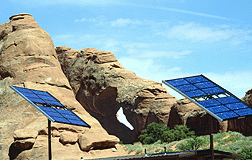|
Method receives thumbs up from industry
New Sandia control method opens doors for more photovoltaic systems being safely linked to electric grid
|

NEW CONTROL METHOD — The new technology developed by Sandia researchers will make it more attractive for people to use photovoltaics and other forms of alternate energy because they can be more easily connected to the electric grid.
(Photo by Randy Montoya)
Download 300dpi JPEG image, ‘Arches.jpg’, 940K (Media are welcome to download/publish this image with related news stories.)
|
ALBUQUERQUE, N.M. — A new way to safely, simply and effectively connect electricity-producing photovoltaic (PV) solar systems to utility company power grids has been developed by the Department of Energy’s Sandia National Laboratories. Already several manufacturers have adapted it into their systems.
Called the “non-islanding inverter,” it is receiving a “thumbs up” from standards organizations and PV system manufacturers around the country. They see it as a door opener for more freestanding PV systems to be hooked up to the nation’s grid.
Basically, it is a safety-centered, Underwriters Laboratories-certified control method that automatically diverts or turns off electricity flow from grid-connected PV systems when an electric distribution line shuts down.
“Electric utility companies are reluctant to connect photovoltaic, or solar cell, units to the grid because of the potential for safety hazards and equipment damage,” says Sandia researcher John Stevens. “This new method eliminates that possibility.”
The problem has been that if a utility needs to shut down power in a distribution line for repair or some other reason, the line must be completely de-energized. This is for the safety of a line worker or a passerby coming in contact with the line.
Before the Sandia development, photovoltaic systems could not determine that a line had been de-energized under all conditions and it could continue sending electricity through the line. Currently, in order for PV systems to be connected to the grid, they must meet specialized hardware requirements for different utility jurisdictions.
The new “non-islanding inverter” permits photovoltaic systems to sense that a line has been de-energized and to automatically shut off power production or divert the electricity to the house or business to which it is connected.
The method comes in the form of computer code built into the inverter portion of the photovoltaic system. The inverter takes DC current from the photovoltaic array and turns it into AC current.
Stevens says the idea emerged a couple of years ago when he was chairing an Institute of Electrical and Electronics Engineers (IEEE) working group that was developing grid-connection PV standards. Among members of the group were representatives of utility companies concerned about hooking up photovoltaic units to the grid.
“We worked on this two years, going down several blind alleys before coming to a good workable approach,” he says.
Working on the project were several people from Sandia’s Photovoltaic System Applications Department and a researcher from Ascension Technology in Boulder, Colo. In addition, an advisory group from the photovoltaics inverter industry provided input.
Stevens says the goal is for inverter manufacturers to adopt the technology as a way to make solar power a more viable option for electricity production. Grid connection means the PV system owner can sell excess electricity. This is good for both the owners who can make a profit and for the utilities that have available additional power resources at peak usage times.
The non-islanding inverter concept also can be used with other types of alternate energy such as fuel cells and microturbines.
In addition, Sandia’s non-islanding inverter has been added to IEEE standards, becoming the first standard of its kind allowing utility interconnection of non-utility-owned distributed generation equipment.
Stevens says older inverters cannot be retrofitted with the new technology because the fit involves adding a computer code. However, he anticipates it will be in nearly every new photovoltaic system built this decade.
Two companies currently have the system in their commercial inverters. They are Ascension Technologies and Omnion Power Electronics Corp. Several other inverter manufacturers are in the process of adapting the technique to their products.
Sandia is a multiprogram laboratory operated by Sandia Corporation, a Lockheed Martin Company, for the United States Department of Energy under contract DE-AC04-94AL85000. With main facilities in Albuquerque, N.M., and Livermore, Calif., Sandia has major research and development responsibilities in national security, energy and environmental technologies, and economic competitiveness.
Media contact:
Chris Burroughs, coburro@sandia.gov, (505) 844-0948
Technical contacts:
John Stevens, jwsteve@sandia.gov, (505) 844-7717
Paul Klimas, pcklima@sandia.gov, (505) 844-8159
| 